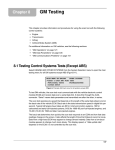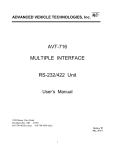Download Diagnosing Starter Problems on the ZR-1
Transcript
Diagnosing and Understanding Starting Problems on the ZR-1 Marc Haibeck 28-Sep-13 There are three basic failure conditions: - A VATS security system lockout - A click from the starter solenoid but no engine cranking - Silence when the ignition key is rotated into the start position VATS Security System Lockout The VATS security system measures the electrical resistance of the ignition key pellet when the ignition key is turned to the on position. If the expected resistance is not detected, the system will prevent the start relay from activating. It will also prevent the fuel injectors from activating. When a VATS lockout is in progress the Security lamp will be lit in the gauge cluster while the ignition key is held in the cranking position and the starter is not activating. Once a lockout is initiated, the system will prevent operation of the start relay for 10 minutes. A lockout can be caused by a poor electrical connection between the key and the lock contacts or by a broken lock contact wire in the steering column. The fuel pump prime cycle will still occur during a VATS lockout. The CCM body control system and the ECM record evidence of a VATS lockout. The CCM collects the best information. Error codes 51 through 63 provide detailed information as to why the VATS event occurred. The ECM will record error code 46 if it was instructed by the VATS system to lockout the fuel injectors. To access the codes, connect two pins in the ALDL connector under the dash together. To view CCM errors on ’90 to ‘93 cars, connect pins A and G. On ’94 and ’95 cars, connect pins 4 and 12. If errors have been recorded, the speedometer display will show them in the 1.0 mode. Refer to the service manual section 8D for detailed information. To view an ECM error on ’90 to ’93 cars connect ALDL connector pins A and B. On ’94 and ’95 cars connect pins 4 and 5. The check engine lamp will blink the error code. When a VATS lockout occurs, the car can’t be push started because the fuel injectors are disabled. If further attempts are made to start the car while the 10 minute VATS lockout period is in progress the lockout period will be extended. The VATS system starter lockout can be disabled by removing the start relay and placing a spade pin jumper in relay socket pins 30 and 87. The fuel lockout can be disabled with a data bit modification in the engine control system calibration chip. A VATS lockout can be caused by moving the ignition key too fast. This should not occur, but if it does the simple solution is to slowly turn the key to on, hesitate a moment and then slowly proceed to the crank position. Turning the key to start too quickly can cause the key resistor pellet to be misread. The Starter Solenoid Clicks But the Engine Does Not Crank The sound of the starter solenoid click is muffled because the starter is located inside the valley of the engine. If the solenoid clicks but the engine does not crank, the solenoid is activating but there is one of two faults in the starter. The solenoid motor contacts may not be connecting the starter motor to the battery. Or, the starter brushes may not be contacting the starter armature because they are worn. The starter must be replaced if one of these conditions exists. In this starter failure mode, the car will push start. Use first gear with an OE 3.45 rear axle gear ratio. Use second gear with a 4.10 rear axle ratio. If the car can’t be pushed, there is a small chance that starter may be vibrated to life by tapping the starter with a pipe while the solenoid is activated. The Starter is Silent When the Key is Turned to Start Make sure the floor mat is not folded under the clutch pedal. This situation requires electrical analysis because there is a long list of suspects. The battery voltage should be at least 12 volts at the battery terminals when the ignition key is turned to start. The battery terminals need to be tight. If present, a battery disconnect switch can develop a poor connection. It may run the interior lights but may not deliver enough current to the starter. Remove the driver’s side hush panel from under the dash. Find the black clutch switch connector. It has purple and yellow 10 gauge wires on one side. The purple wire is red on the first three hundred or so ’90 cars. Measure the voltage on the purple wire when the key is turned to start. It is normally 10 to 11 volts when the engine is cranking. If the voltage is less than one volt there is an open in the starter solenoid circuit. The starter solenoid could be open. The clutch pedal switch could be open. The start relay could be open. If the voltage is more than one and less than 10 volts there is too much electrical resistance in the circuit. Measure the voltage drops across the three items listed above. Measure the current on the purple wire. The current is normally 28 to 30 amps when the starter solenoid initially is connected. This is the solenoid pull-in coil current. The current drops to nine to 10 amps when the starter is cranking the engine. This is the solenoid hold-in coil current. If the current is 28 to 30 amps and the starter is silent, the starter solenoid is ether stuck physically or the solenoid coil has shorted turns and can’t develop enough of a magnetic field to pull the solenoid plunger in. If there is an excessive voltage drop in the solenoid circuit, and there is a solenoid plunger or solenoid coil related problem, the problem will be worse when the engine is hot because the heat increases the voltage drop in the wiring and thus reduces the current to the solenoid coil. Wiring Diagrams ‘90 to ‘92 These voltage measurements were made with a starter that had a silent no cranking problem. The current is 28 to 30 amps when the ignition key is turned to start and the starter is silent when it should be cranking. This is the solenoid pull-in current. The current flow is shown in red. Typical voltages are marked in blue. For these measurements the voltage at the battery terminals was 12.2 volts. The voltage differences between points are voltage drops. The meter was connected between the points shown and the negative battery terminal. If the starter works correctly and the plunger pulls in to run the motor the current will reduce to the solenoid hold-in current of nine to 10 amps. 12.2 v 11.7 v 11.3 v Meter negative. 11.2 v 11.1 v From the GM service manual. ’93 to ‘95 In ’93 GM improved the starter solenoid circuit wiring. The clutch switch connections were moved to the armature side of the start relay. This reduces the load on the clutch switch from 30 amps to .2 amp. It also eliminates the approximately .050 volt normal voltage drop across the clutch switch and its wiring at 30 amps. From the GM Service manual. The 24 Volt Wakeup Call I have been able to revive two silent starters. One was on a car that was stored in a climate controlled room and not started for 10 years. Another was on a car that was stored in a cold garage and not started over a Chicago winter. Both cars continued on for many years without a further starter problem. I suspect that these cars had high plunger friction after the storage periods. The plunger pull-in force can be doubled by applying 24 volts. Place a second battery in series with the car battery. Apply the 24 volts to the purple wire. Apply the current for one half second to prevent overheating the solenoid. Car Bat. Neg Boost Bat Pos Neg 24 volts. Pos 12 gage wire to the purple wire. The wire should be less than 25 inches long. Jumper Cable To Car Chassis To Car Electronics Starter Installation Tips Bend the purple solenoid wire so that when it is plugged in, there is tension on it. This will minimize fretting on the terminal pin due to vibration. The battery terminal stud is sensitive to rotation. If it is rotated, the contact inside the solenoid will twist out of alignment. This can result in the plunger contactor making a connection on the corner of the contact rather than across the face. This can greatly shorten the life of the contact. Hold the battery cable stationary when tightening the nut to prevent rotation of the stud. This is a picture of a solenoid with new contacts. Don’t let the battery cable stud rotate when tightening the cable. The contacts need to be level and square with the housing so that the plunger contact disk will lie evenly across them and make contact across the full faces of the contacts. The battery terminal stud does not have an anti-rotation stop. If it moves when tightening the cable it will lift the corner of the contact. Then the plunger will make a point contact rather than a full-face contact. This leads to shortened contact life and potentially a click and no cranking failure. An Observation About the Solenoid Coil OE solenoid coils that I have seen are wound unevenly. The turns of wire cross over each other. This creates pressure points that might break down the shellac insulation coating on the wires and lead to a short circuit between turns. The insulating coating is further stressed by the oven like environment that the starter lives in. This could cause a silent no start condition. The coil on the right is a new replacement part coil. It is smoothly wound. Maybe the smoothly wound coil is more durable.














